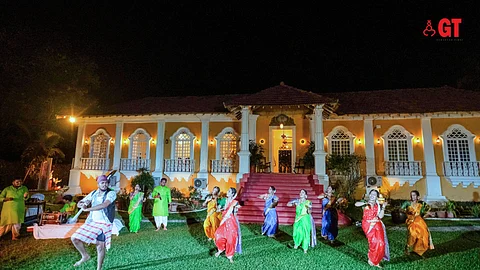

It’s around 7 pm, and the string lights have been turned on. There is laughter and chatter on the well-maintained lawns, an inviting sound that welcomes you to this beautiful 350-year-old heritage house.
The Silva Heritage Resort & Spa in Benaulim, that once belonged to a mayor of Salcete, now welcomes guests from all over the world.
Last weekend, it hosted a unique presentation – The Goan Cultural Festival. Nestled amidst the serene beauty of the resort, attendees immersed in an evening filled with traditional activities, culinary delights and lively dances that captured the essence of Goa.
The owner of Silva Heritage Resort & Spa, Smita Antao, shared that, as a tourist, she always wanted to get the feel of the place and experience the local culture wherever she travelled.
“We realised that tourists coming to Goa might want a similar experience and that was something that we don't offer in Goa. So, this idea had been brewing in our minds, but came to fruition in the last few months," she explained.
"We were already giving in-house guests singular experiences, but have combined dances, dinner and handicraft activities to enable guests to feel the pulse of our land in one evening,” she added.
That is when the team put together a cultural extravaganza which focused on revisiting Goa’s traditions and culture.
Guests were accorded a traditional welcome, in keeping with the Indian mantra of Atithi Devo Bhava. The festival commenced with an insightful session on one of Goa's iconic beverages – cashew feni – elucidated by Hansel Vaz, of Cazulo Premium Feni.
Ninoschka Pinto, from Candolim, was excited to visit the festival.
“The feni counter was more than just an open bar. Expending knowledge to all who were interested, Hansel explained to us the different types of fenis available. Although feni has been connected to cashews worldwide, it was intriguing to learn that feni is also made from coconut, among other fruits," Ninoschka said.
"This fact was further given gravity by the toddy tapper sitting by the coconut trees, happy to answer any, and all, questions about his life's work,” she added.
As the evening unfolded, the air was filled with the infectious rhythms of Goan folk dances and the melodious beats of the ghumot, a traditional Goan percussion instrument.
The guests joined in and swayed to the tunes, and experienced the joy of Goan dance forms.
The dhekni, mussoll dances ended in an invitation to the guests to join in and wind up the fantastic evening dancing to the popular tune of Maria Pitache.
“What shocked me was a comment made by one of the visitors, ‘If I hadn't known better, I would have thought I was in Kerala! Who knew Goa had such a beautiful culture?’” said Savia de Sousa from Guirim, who visited along with her friend, Akshada Godinho from Panjim.
"It was with a thrill that people tried to smoke their fish in hay, and an even greater joy when they succeeded. It was a novel experience for many,” added Savia.
From grinding masalas on a traditional grinding stone (roggdo) to weaving intricate baskets from palm leaves, to learning the art of weaving palm leaves into durable mats (called mollam) and shaping clay into pottery, attendees embraced the craftsmanship and artistry that define Goan culture.
Goans had a fun time, too, as they witnessed the unique cooking technique of frying fish on hay, as well as mastering the art of making shirvolyo, a beloved Goan delicacy.
As the evening unfolded, the air was filled with the infectious rhythms of Goan folk dances and the melodious beats of the ghumot, a traditional Goan percussion instrument.
Sherwin Antao, the owner, feels that tourists must get a gist of the true Goa.
“With this, we hope to give tourists a flavour of our rich culture. And, going forward, we want to make it a bit interactive as well. We need to come together if we want to change the common perspective that Goa is only about beaches and parties."
"Through these efforts, we hope to not only preserve Goa's unique traditions, but also share them with a wider audience, enriching the cultural landscape and strengthening the bonds that unite us all,” Sherwin concluded.